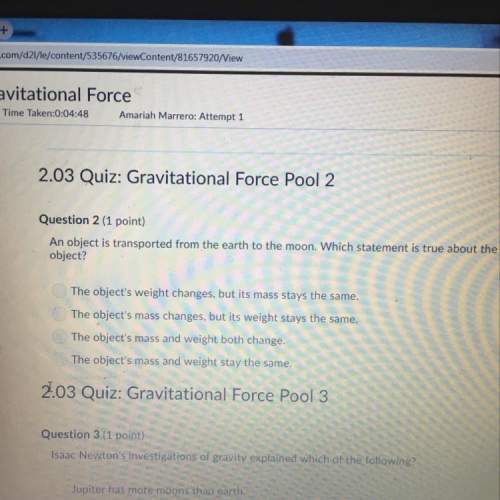Which is the most likely to be reduced?
оа. zn2+
ов. fe2+
ос. cu2+
od. fe3+...

Chemistry, 21.11.2019 21:31 anthonylopez1
Which is the most likely to be reduced?
оа. zn2+
ов. fe2+
ос. cu2+
od. fe3+

Answers: 2


Another question on Chemistry

Chemistry, 20.06.2019 18:04
Can anyone (a-level) a student was analysing a carbonate compound, mco3, containing an unknown group 2 metal, m. the student carried out thermal decomposition on 0.730g of the carbonate and measured the volume of gas produced. mco3 (s) mo (s) + co2 (g) the student collected and measured 120cm3 of carbon dioxide. 1 mol of carbon dioxide occupies 24 000 cm3 under these conditions. calculate the molar mass of the group 2 carbonate and hence deduce the identity of the group 2 metal, m.
Answers: 3

Chemistry, 21.06.2019 21:00
Which of the following compounds does not contain molecules? question 2 options: co2 h2 nacl h2o
Answers: 1

Chemistry, 22.06.2019 03:00
Flourine is found to undergo 10% radioactivity decay in 366 minutes determine its halflife
Answers: 3

Chemistry, 22.06.2019 11:40
Effect of rotenone and antimycin a on electron transfer rotenone, a toxic natural product from plants, strongly inhibits nadh dehydrogenase of insect and fish mitochondria. antimycin a, a toxic antibiotic, strongly inhibits the oxidation of ubiquinol. (a) explain why rotenone ingestion is lethal to some insect and fish species. (b) explain why antimycin a is a poison. (c) given that rotenone and antimycin a are equally effective in blocking their respective sites in the electron-transfer chain, which would be a more potent poison? explain.
Answers: 3
You know the right answer?
Questions








Mathematics, 02.11.2019 05:31



History, 02.11.2019 05:31

English, 02.11.2019 05:31


Physics, 02.11.2019 05:31


History, 02.11.2019 05:31

Mathematics, 02.11.2019 05:31






